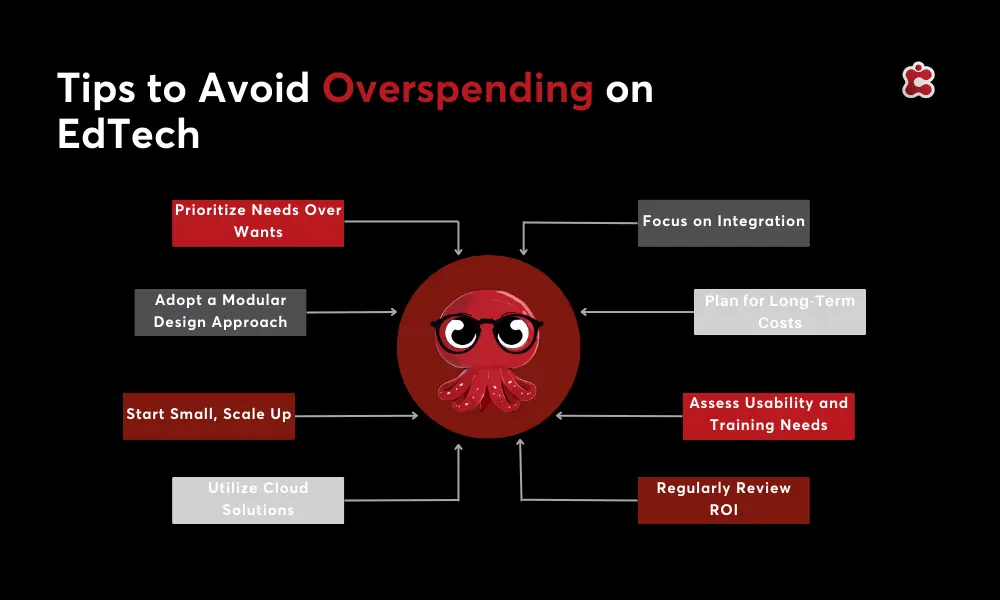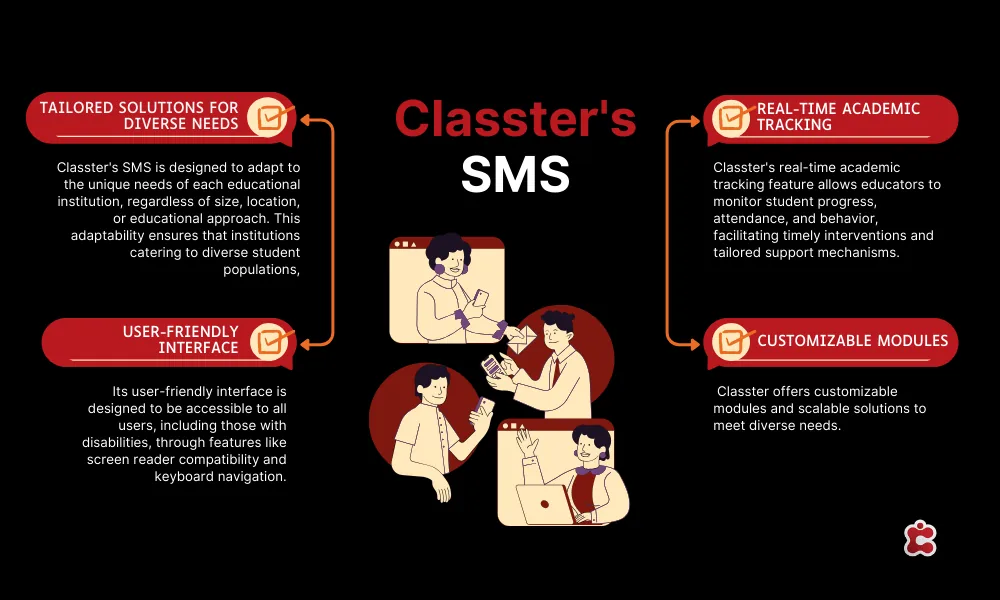Today, there’s software for everything. Need to automatically mark attendance? No problem; your Student Information System (SIS) has it covered. Want to create a smoother enrollment process? Done, your School Management System (SMS) will make it a breeze. EdTech is changing the game for schools.
But let’s not forget the money side of things.
With so much technology out there, it can be tough to figure out where to spend within a limited budget. How do you choose the right EdTech solutions without breaking the bank?
We’ll show you how to make those smart EdTech investments. We’ll walk you through how to prioritize the features you really need and how to avoid spending on things you don’t.

The EdTech Landscape: Key Solutions to Consider
So, before we talk about budget, let’s review some essential software that your school should be investing in. These tools are the backbone of a well-run school, streamlining operations, improving communication, and supporting both administrative and educational goals. Here’s a breakdown of the key systems that can make a real difference in your school:
| System | What It Does |
| Student Information Systems (SIS) | Streamlines administrative tasks improve data management and enhances communication with students, parents, and teachers. |
| School Management Systems (SMS) | Centralizes school operations to simplify daily tasks, improve efficiency, reduce errors, and ensure smooth day-to-day management. |
| Learning Management Systems (LMS) | Supports teaching and learning with digital tools that engage students, offer flexibility, and allow for personalized learning experiences. |
| Financial Management Systems | Helps track budgets, manage expenditures, and ensure the school stays financially healthy with clear reporting and insights. |
| Customer Relationship Management (CRM) | Improves communication and relationships with students, parents, and staff by keeping track of interactions and improving engagement. |
SIS, SMS, LMS. What’s the Difference?
While it might seem that SIS, SMS, and LMS all do the same thing, they actually serve different needs in the education ecosystem. Student Information Systems (SIS) primarily handle the nuts and bolts of student data management. This includes tracking attendance, grades, enrollment, and even student behavior. It acts as the go-to resource for administrators needing up-to-date, organized records and a way to connect with parents and students efficiently.
School Management Systems (SMS) take a broader approach, providing a comprehensive solution to streamline every aspect of a school’s daily operations. From finance, scheduling, and HR to managing extracurricular activities, SMS is designed to reduce paperwork, improve efficiency, and ensure schools run smoothly without unnecessary hassle. It’s a great tool for administrators who want everything from budget management to staff communications in one place.
On the other hand, Learning Management Systems (LMS) are all about enhancing learning experiences. They support teachers in creating digital lesson plans, managing assignments, hosting discussions, and assessing student progress online. LMS tools make learning flexible, engaging, and personalized, which can be a big game-changer for student success.
What to Look for in EdTech Tools
Now that we understand what tools are valuable for your school let’s break down what you should look for in each one. These features will ensure longevity, which ultimately means your investment will continue to pay off for years to come.
- Ease of Use: The last thing you need is a tool that requires endless training. Look for software with a user-friendly interface that’s intuitive for both teachers and administrators. The easier it is to navigate, the faster your staff can get up to speed, saving you time and resources.
- Integration Capabilities: Your school likely already uses a variety of systems, so choose EdTech tools that can easily integrate with them. Seamless integration means less time spent manually transferring data,.
- Scalability: You want tools that grow with your school. Whether your student body is expanding or your needs are changing, make sure the EdTech solutions you choose can scale to meet future demands without requiring a complete overhaul.
- Customization: No two schools are the same, so why should your software be? Choose tools with customizable features that can be tailored to your specific needs, whether it’s a particular workflow or unique reporting requirements.
- Support and Training: Ongoing vendor support and accessible training resources are crucial. The right support ensures smooth adoption and helps you overcome any challenges as you implement new systems.
- Data Security: Protecting sensitive student data is a top priority. Ensure your tools comply with data security regulations and offer robust protection for your school’s information.
Tips to Balance Tech with Budget Constraints
When it comes to balancing tech with budget constraints, a little strategy goes a long way. Here are some practical tips to help you make smart, cost-effective decisions while still getting the tools your school needs to succeed.
Tip1
Start by identifying the areas where technology can have the biggest impact. Is it streamlining administrative tasks, enhancing teaching, or improving financial management? By knowing where your school needs the most support, you can narrow down your options and make a more targeted investment.
Tip 2
Focus on the essential features that address your school’s core needs. It’s easy to get caught up in shiny extras, but avoid overspending on features that aren’t immediately necessary. Invest in tools that solve specific problems now and leave the additional features for later.
Tip 3
Open-source or flexible software can be a great way to reduce initial costs. These solutions allow for customization and can evolve as your needs change, saving you money in the long run.
Tip 4
Software-as-a-service (SaaS) platforms typically require a lower initial investment so that you can avoid costly hardware and maintenance. Cloud-based solutions are also scalable, meaning you only pay for what you use, making it easier to stay within budget.
Tip 5
Don’t hesitate to negotiate with vendors. Many EdTech providers offer flexible pricing, discounts for educational institutions, and even financing options that can help spread the cost over time.

How to Avoid Over-Spending
One of the best ways to avoid overspending on EdTech is to opt for a modular design. With a modular approach, schools can choose only the features they need, which means you’re not paying for extra tools that won’t be used. For example, if you only need a basic Student Information System (SIS) to track attendance and grades, you can start with just those modules and add more advanced features later as your needs grow. This way, you’re only investing in what’s essential at the moment and have the flexibility to scale up when the time is right. Modular systems also allow schools to adjust their investment based on changing requirements, helping to avoid wasting money on unnecessary tools or upgrades. This approach ensures that your budget is spent strategically, maximizing the value of every dollar spent.
Classter: All Your EdTech Needs In One Place
If you want an innovative EdTech solution that covers it all, look no further than Classter. Classter offers a comprehensive, all-in-one platform with modules designed to simplify every aspect of school management. From Student Information Systems (SIS) that automate administrative tasks to School Management Systems (SMS) that centralize daily operations, Classter has you covered.
What’s great is Classter’s modular design—you only pay for what you need. Whether you’re a small school or a large institution, you can tailor the platform to fit your unique needs, making it cost-effective and scalable.
Ready to see it in action? Get a free demo and discover how Classter can transform your school’s operations.
FAQ’s
Every school should invest in a core suite of EdTech solutions that streamline daily operations, support teaching, and enhance communication. These include Student Information Systems (SIS) for data management, School Management Systems (SMS) for operational efficiency, Learning Management Systems (LMS) for digital learning, and financial management tools to maintain budget transparency.
To avoid overspending, schools should start by identifying critical needs, focus on must-have features, and select modular solutions that allow for scalability. Cloud-based Software-as-a-Service (SaaS) platforms can also reduce initial costs and maintenance.
Classter offers an all-in-one platform that includes SIS, SMS, LMS, CRM, and ERP modules. Its modular design allows schools to pay only for the features they need, making it scalable and cost-effective.

